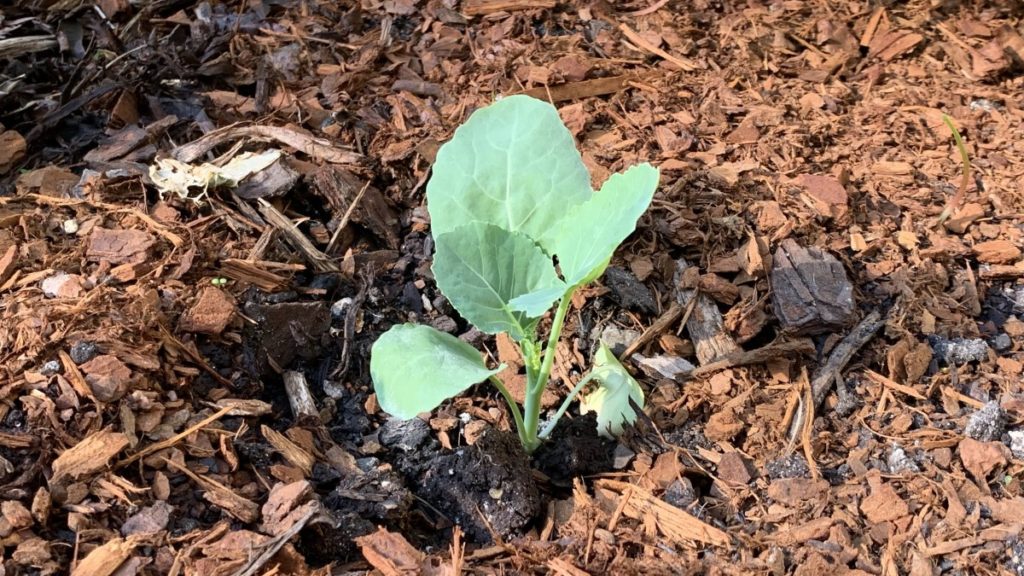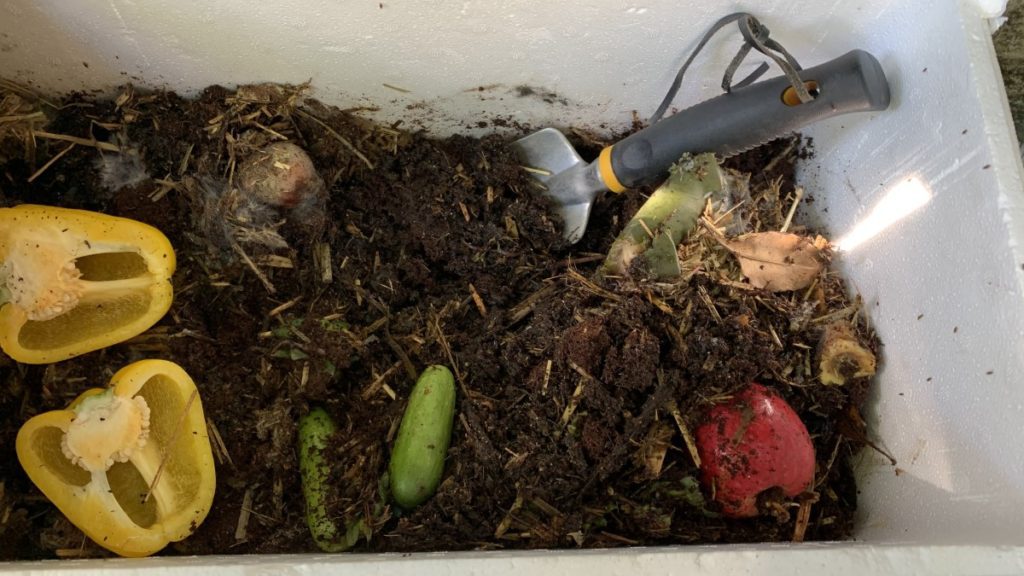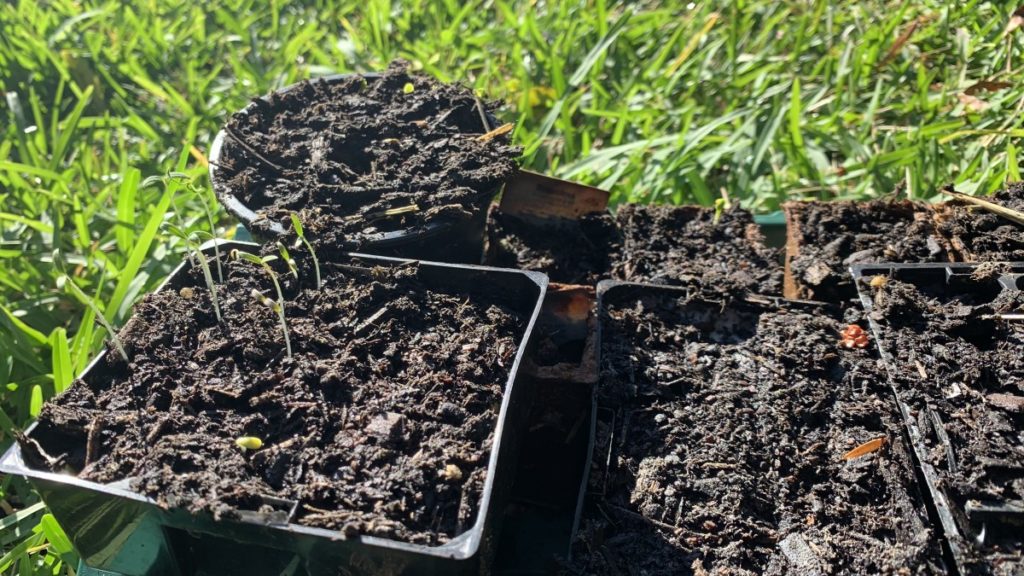Use worm castings to help seedings grow by mixing it through garden beds, pots or raised vegetable beds. Worm castings are a fantastic soil conditioner and gently add nutrients to the soil in a form that they can easily absorb. Worm castings will help your seedlings to grow a strong, healthy root system, absorb the nutrients they need and improve the soil.
6 Simple steps to use worm castings for seedlings
Here are 6 easy steps to harvest worm castings from your worm farm and to add them to your potting mix or soil. This is the perfect preparation for any seedlings including flowers, vegetables and fruit.
- Remove the lid of your worm farm to encourage the worms to dig down deeper away from the surface.
- Use a small trowel or gloved hands to scrape worm castings from the top of your worm farm.
- Put the worm castings into a small bucket.
- Mix through 25% worm castings into potting soil or garden bed.
- Make a small hole for your seedling, place the seedling in the hole and backfill with the worm casting mix.
- Water the seedling in well.
Worm castings can be used for fruit, vegetable or flower seedlings mixed into the soil or scattered on top of the root zone.
How to plant seedlings using worm castings
To plant seedlings into worm castings, mix through 25% worm castings into garden soil or potting mix. Worm castings are too rich on their own and you seedlings will grow better when soil is added.
It is important to mix some soil with your worm castings before planting seedlings in it. Worm castings on their own are similar to a compost material and don’t have the structural elements of soil.
Most productive agricultural soils range from 3-6% organic matter, according to Cornell University. The rest of the soil is made up of minerals, air and water and can be a mix of sand, silt or clay type. These give the soil structure and minerals to hold and feed your plants.

This makes worm castings the perfect addition to soil they contain a rich amount of organic matter and nutrients from the food scraps that the worms have broken down in your worm farm.
How to use worm castings for seedlings
Use worm castings for seedlings by digging in a handful into the soil that you will backfill around your seedling. You can also sprinkle a small handful of worm castings around the top soil of the seedling.
The nutrients will be washed down from the worm castings to the plant roots as it rains or when you water them like fertilizer. Worm castings will also build up the soil microbes in your garden which will make nutrients from the soil available for your seedlings as they grow.
When to use worm castings on seedlings
The best times to use worm castings on seedlings are at the time of planting and sprinkled on top as a fertilizer. When you are planting new seedlings that you have grow at home or bought from a garden center, add 1 handful of worm castings to the soil that you are using to backfill the seedling.
The other time to use worm castings is to sprinkle around your seedlings after you have planted them. You can apply a handful sprinkled around your seedling each month as they grow. This is great for vegetable seedlings like tomatoes, broccoli, peppers and cauliflower. All seedings will benefit from a sprinkle of worm castings.

I also sprinkle worm castings around my newly planted annual flowers like dianthus and violas. I then cover the worm castings back over with mulch. This stops them from drying out an allows the good microbes to make their way through the soil.
How often to use worm castings on seedlings
I use a handful of worm castings each month on seedlings over the growing season. This is when the seedling is growing to full size over fall for winter flowers and vegetables and spring. You can then add more worm castings to your established plants as this is a mild soil conditioner so will not burn your plants.
You can also mix worm castings in with a bucket of water and add them as a liquid fertilizer. This is a great way to add extra nutrients and water your seedlings at the same time. To make a supercharged mix add 2-3 handfuls of worm castings, liquid seaweed tonic and fish emulsion to a 5 gallon bucket and fill with water.

This will be a fantastic soil conditioner and fertilizer to get your seedlings off to the best start. This amount will water a large area of your garden and is great for the soil even if you don’ have any plants in yet.
Benefits of worm castings for seedlings
Worm casting contain a range of nutrients and microbes that have been processed by the worms and are a great addition to the soil for planting seedlings. They will act like a slow release organic fertilizer and soil conditioner adding both soil microbes, organic matter and nutrients to your soil.
Using worm castings for growing seedlings – FAQ
Worm castings won’t burn seedlings because they are a mild soil conditioner with no excess nutrients that can affect plant roots or leaves. Worm castings are a safe soil conditioner to add to your garden, raised vegetable beds or pots before planting seedlings. You can also scatter them on top of the soil after planting if you forget to add them before.
Worm castings are fantastic addition for tomato seedlings as they will add nutrients and organic matter to the soil. If you are planting tomatoes into an existing garden bed, they will add back nutrients that were absorbed by plants previously in the soil.
Tomatoes are a hungry plant so benefit from adding extra nutrients and water holding capacity from the worm castings. The microbes in the worm castings will make nutrients in the soil available to the tomato as well as those broken down from the food scraps in your worm farm.
To start seeds in worm castings mix through a 50:50 mix of worm castings with coconut coir. The coconut coir fiber will add extra structure to the worm castings and be the perfect place to start your seeds. Worm castings on their own will not hold their structure as well as mixing them through with coconut coir.
Starting seeds in worm castings

You could also mix worm castings through as a 50:50 mix with seed starting mix. This will provide the seeds with longer lasting nutrients and you can keep them longer in the pot that they are started in. Seed raising mix does not have added nutrients so adding worm castings will provide a nutrient rich mix to allow your seeds to grow to a bigger size before you need to plant them out.
If you are planting seeds straight into your garden bed, mix a 50:50 mix of worm castings with seed starter mix or coconut coir and sprinkle it on top of the seeds. This will help to hold moisture for longer in the soil providing the ideal environment for seeds to sprout and grow.
I am an accredited practicing dietitian, experienced gardener and a dedicated cook. I love writing and sharing my experience so you can learn from my successes and mistakes.

Comments are closed.